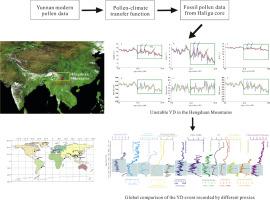当前位置:
X-MOL 学术
›
Palaeogeogr. Palaeoclimatol. Palaeoecol.
›
论文详情
Our official English website, www.x-mol.net, welcomes your feedback! (Note: you will need to create a separate account there.)
Evidence for climate instability during the Younger Dryas interval in the Hengduan Mountains, Yunnan, southwestern China
Palaeogeography, Palaeoclimatology, Palaeoecology ( IF 3 ) Pub Date : 2020-09-01 , DOI: 10.1016/j.palaeo.2020.109798 Yi-Feng Yao , Xia Wang , Feng Qin , Alexandra H. Wortley , Su-Ping Li , Stephen Blackmore , Cheng-Sen Li , Yu-Fei Wang
Palaeogeography, Palaeoclimatology, Palaeoecology ( IF 3 ) Pub Date : 2020-09-01 , DOI: 10.1016/j.palaeo.2020.109798 Yi-Feng Yao , Xia Wang , Feng Qin , Alexandra H. Wortley , Su-Ping Li , Stephen Blackmore , Cheng-Sen Li , Yu-Fei Wang

|
Abstract The Younger Dryas (YD) is the most recent abrupt climatic event recognized during the transition from the last glaciation to the Holocene. Growing evidence from the middle and high latitudes of Europe and North America shows that the climate within the YD event was highly unstable. Until recently, however, climate instability during this event has received little attention elsewhere in the world. Here we present evidence of a climatically unstable YD based on pollen-climate transfer function and REDFIT spectral analysis of pollen data from Haligu in the Hengduan Mountains of southwestern China, a low latitude temperate biodiversity hotspot. Our data show that the climate fluctuated significantly during the YD, with three warm peaks recognized at 11.5, 11.7 and 12.3 cal kyr BP. In particular, we estimate a gradual rise in mean annual temperature by 3.7 °C between the end of the YD and the early Holocene (11.2–10.9 cal kyr BP). In response to this, the subalpine conifer forest dominated by Picea and Abies may have migrated about 610 m upwards. We also detected that the climate fluctuations during the YD-Holocene transition show significant centennial periodicities of 76 yr, 84 yr, 91 yr, 95 yr, and 638 yr. The former four cycles are possibly related to the Gleissberg (around 80 yr) solar cycle, which was also detected in the Hongyuan peat, the PC-6 core of the East China Sea and the GISP2 ice core. These new findings enhance our understanding of millennial-scale abrupt climate events which may be of great significance in predicting the impact of future climate change on mountainous ecosystems in southwestern China. The warming at the end of the YD may provide a potential analog for global warming in the near future, during which the upward migration of vegetation zones will likely lead to the loss of habitat for threatened species. We therefore should take action to restore habitats and provide protected areas for species at risk.
更新日期:2020-09-01


























 京公网安备 11010802027423号
京公网安备 11010802027423号